



Nutrient Requirements Of Beef Cattle
By David Lalman, Associate Professor, Beef Cattle, Oklahoma State University Extension.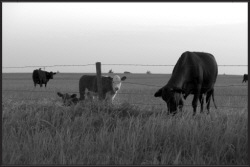
Objectives
- Discuss the nutrient requirements of beef cattle.
- Provide tables that list the nutrient requirements of beef cattle.
A balanced and cost effective nutrition program is essential to the success of any beef cattle operation. Expensive grasslands demand effi cient utilization of forages. Supplemental feeding and complete feeding programs must be designed to meet the nutrient needs of beef cattle and, at the same time, make the most of the available feed resources. Nutrient requirements of cattle change with age, stage of production, sex, breed, environmental conditions, and basal diet quality and amount. Therefore, gaining knowledge of nutrient requirements and the factors infl uencing these requirements is a necessary fi rst step to designing a nutrition program that is both effi cient and cost effective. This section will discuss the protein, energy, mineral, and vitamin requirements of beef cattle. In addition, tables of nutrient requirements are provided.
Dry Matter Intake
There really is no requirement for feed intake, although an estimate of how much forage and feed that a cow will consume is essential when evaluating rations, supplements, or predicting animal performance. Dry matter (DM) intake is infl uenced by a number of different factors. A few of the more important variables include animal weight, condition, stage of production, level of milk production, forage quality, amount and type of supplement or feed provided, as well as environmental conditions.
Cattle have a daily requirement for a certain quantity of specifi c nutrients such as protein, calcium, and vitamin A. The necessary concentration of these nutrients in the diet (to meet the animal’s requirement) is then determined by the amount of feed consumed. For example, steer calves gaining 2 lb per day may require 1.6 lb of protein per day. If they consume 15 lb of DM daily, the protein requirement could be expressed as 10.7% of DM intake. On the other hand, if they are limit fed to consume only 10 lb of DM daily, the protein requirement for 2 lb of gain could be expressed as 16% of DM intake.
Intake in forage fed cattle is generally limited by the forage capacity of the digestive tract. Values presented in Table 1 provide rule-of-thumb guidelines for variation in DM intake based on differences in forage quality and stage of production for beef cows. Forage digestibility values rarely exceed 70 to 74% of dry matter. Calves and yearlings are frequently fed higher quantities of concentrate feeds to improve weight gain and feed conversion above what can be achieved with forage alone. When diet digestibility approaches around 70%, feed intake is no longer regulated or limited by the capacity of the digestive tract. Rather, with diets high in digestible energy, physiological mechanisms are turned on to limit intake (Figure 1). This response can be thought of as a built in safety mechanism so that cattle are less likely to consume too much of a highly digestible diet, causing digestive upset, bloat, and founder.
Forage intake is highly correlated with forage quality as shown in Figure 2 and in Table 1. The more rapid rate of digestion and passage of higher quality forage results in considerably higher dry matter intake compared to forage that is lower in digestibility.
Cattle with greater mature body weight and frame consume more forage compared to smaller frame cattle and lactating cows consume considerably more of the same quality forage compared to gestating cows (Figure 3). Additionally, cattle that are fl eshy consume 3 to 10% less feed or forage compared to cattle that are in average to thin condition. Cold stress increases dry matter intake, while heat stress reduces dry matter intake. With this many factors infl uencing this trait, it is obvious that dry matter intake is very diffi cult to accurately predict.
Estimates of dry matter intake presented in the nutrient requirement tables are determined using published prediction equations. These equations take into account the effects of the animal’s weight, level of milk production for lactating cows, energy content of the diet, stage of production, and body condition in the case of the pregnant replacement heifers. It is important to note that all of these equations assume that adequate protein is supplied in the diet to maximize ruminal fermentation. In other words, if the diet is defi cient in protein, these dry matter intake values will overestimate the amount that the cattle will actually consume.
Protein
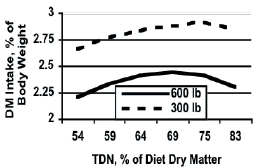
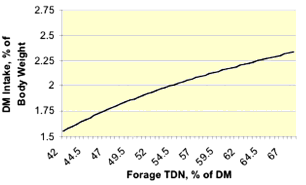
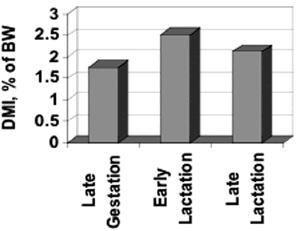
Proteins are large chemical units made up of hundreds of amino acids. Amino acids, in turn, are organic (carbon containing) compounds that also contain nitrogen, oxygen, and sometimes sulfur. Animals consume proteins in their diets and then utilize the amino acids for synthesis of muscle, blood proteins, and other body components. In swine, poultry, and other non-ruminants, the amino acids must be supplied in defi nite proportions in the diet. However, in ruminants, microorganisms (bacteria and protozoa) breakdown most dietary proteins and incorporate the nitrogen and amino acids into their own body tissue. The microorganisms are digested in the small intestine of the ruminant animal. The bacteria themselves have a protein requirement and must have adequate protein to do their job of digesting roughages to end products that can be utilized by the cow.
Because of the ruminal breakdown of dietary proteins and because the amino acid make-up of microorganisms is adequate for most classes of beef cattle, feed and forage amino acid composition is generally not critical compared to non-ruminant diets. On the other hand, a high priority should be placed on providing adequate ruminally available protein in order to allow the bacteria to grow and digest roughages. Chemical crude protein concentration is determined by multiplying the feed nitrogen concentration by 6.25 because protein molecules contain an average of 16% nitrogen (1/16 = 6.25). The crude protein system has been the standard for evaluating beef cattle protein requirements and dietary supply for a long time.
More recently, the metabolizable protein system has been used to better characterize protein degradability as well as its site and extent of digestion. In order to effectively use this new system, the user must become familiar with several new terms.
These include degradable intake protein(DIP), undegradable intake protein (UIP), and metabolizable protein (MP). Degradable intake protein is the feed protein fraction that is degraded in the rumen. Nitrogen from DIP is either used for microorganism protein synthesis or passes through the rumen wall into the blood stream and is carried to the liver as ammonia. In the liver this nitrogen can be converted to urea after which it is recycled to the rumen through saliva or fi ltered out of the blood stream in the kidney to be excreted in the urine. Undegradable intake protein is the feed protein fraction that bypasses fermentation in the rumen to be degraded and absorbed in the small intestine. Metabolizable protein is the sum of protein derived from microorganism origin plus UIP (Figure 4).
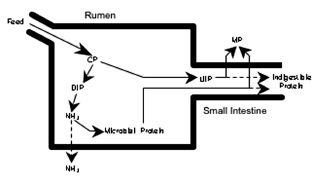
Figure 4. Illustration of protein digestion and absorption in the ruminant.
Perhaps one of the most practical applications of the MP system is the calculation of the animal’s DIP requirement to insure optimal rumen function. For this reason, feed DIP values are included in most feed composition tables. The requirement for DIP is thought to be closely associated with the amount of fermentable energy in the diet. Specifi cally, the DIP requirement can be calculated as 10 to 13% of daily total digestible nutrient (TDN) intake. Lower values in this range are used when the cattle are receiving a low quality diet, such as dry winter range forage or low quality hay, whereas higher values in the range are used when the cattle are receiving high quality forage or a ration including at least 50% concentrate. The UIP value of the feed can also be calculated by subtracting the DIP value from one.
Example of DIP requirement and supply: Assume a cow is consuming 25 lb of hay dry matter that contains 50% TDN. The cow therefore consumes a total of 12.5 lb of TDN per day. Therefore, the DIP requirement is 12.5 lb x 10%, or 1.25 lb of DIP per day. If the hay contains 6% CP (dry matter basis), of which 65% is DIP, this cow would consume 0.98 lb of DIP each day (6% x 65% x 25 lb). The requirement for supplemental DIP would be 0.27 lb (1.25 lb - 0.98 lb).
Nutrient requirements, including protein requirements, for beef cows and replacement heifers are shown in Tables 2 and 3. Requirements for growing calves and yearlings are shown in Tables 4 and 5. Requirements for growing and mature bulls are shown in Table 6. These values were adapted from the National Research Council’s Nutrient Requirements of Beef Cattle publication (2000). One exception is that the NRC calculates the crude protein requirement for some classes of cattle to be less than 7%. Research demonstrates that ruminal fermentation may be compromised with low protein diets. Therefore, 7% dietary crude protein was the minimum value used in the nutrient requirement tables in this publication.
The requirements are expressed in both pounds per day of crude protein and in terms of the percentage required in the diet dry matter. These tables illustrate the infl uence of age, weight, desired rate of weight gain, stage of production, and genetic milking ability on nutrient requirements.
Replacement heifers need to gain about 1.0 to 1.5 lb/day in order to reach 60 to 65% of their expected mature weight and puberty by 15 months of age. They also need to gain around 1 lb/ day from the time they are bred until they calve in order to reach approximately 80% of their mature weight when they calve for the fi rst time. The requirement of protein for muscle and organ growth is refl ected in the large daily requirement for protein. Growing heifers require a high concentration of protein in the diet because of their low dry matter intake. They must have access to good quality forage or be fed supplemental protein to achieve adequate growth prior to their fi rst breeding season.
Gestation has little effect on the cow’s protein requirement until about the seventh month of pregnancy. About 2/3 of the fetal growth occurs during the last 1/3 of pregnancy and the protein intake of the cow should be increased during the last 1/3 of pregnancy to insure that the cow will be in good condition at the time of calving. The cow is programmed to take care of the fetus at the expense of her own body, and losses of body condition frequently occur in late pregnancy when daily protein or energy are not increased to match the needs of the pregnant cow. Adequate dietary protein during this period is also essential for the cow to produce abundant, high quality colostrum (fi rst milk), which will infl uence the newborn’s immune system for the remainder of its life.
Lactation is the most nutritionally stressful activity for the cow. The modern commercial beef cow produces around 20 lb of milk each day during peak lactation. Milk contains a high concentration of protein. Therefore, lactating cows, particularly during early lactation, require nearly twice the daily protein of dry cows. Research shows that cows in moderate condition at calving should at least maintain body weight from calving to rebreeding for good conception rates. Failure to take into account the increased protein demand brought on by lactation may result in long intervals before rebreeding. Beef breeds with superior milking ability (25 to 30 lb/day), and high producing cows within a breed or herd have an even higher protein requirement.
Increasing cow size adds to the daily protein requirement but not nearly to the extent that lactation does. As mature size increases, more protein is required to maintain the heavier muscle mass and to permit faster gains that must be made by young females of larger breeds.
Energy
The cow requires energy for grazing, traveling, fetal development, milk production, temperature maintenance, reproduction, digestion, and voiding of body wastes. In addition, fi rst and second calf cows require additional energy for growth until they mature at about four years of age. If cows are thin, additional energy will be required to restore their body condition to a moderate level. The bulk of energy for grazing cattle comes from rumen digestion of forages and roughage products. With proper amounts of protein and minerals, the rumen is capable of getting energy from a wide range of feeds that are useless to non-ruminants.
Because the rumen bacteria themselves require protein, just as the animal’s body does, it is impossible to discuss ruminant energy requirements separately from ruminant protein requirements. With too little protein in the diet, the bacteria will not effi ciently digest roughages, while with too much protein in the diet, the protein will be deaminated (the nitrogen removed) and used as a very expensive energy source.
Energy requirements are expressed in the table in terms of TDN and net energy for maintenance (NEm) and (or) net energy for gain (NEg). TDN is the sum of the digestible starch, fi ber, protein, and fat in a feed with a correction factor for the high energy content of fat and the amount of ash or mineral content. TDN requirements are expressed as a percent of the diet dry matter as well as in pounds per day required. Net energy requirements are expressed in terms of mega calories per pound of feed and mega calories required per day.
A close look at the nutrient requirement tables shows that the same factors that infl uence protein requirements also infl uence energy requirements: animal weight, rate of gain, lactation, and fetal development. Lactation represents the greatest need for additional energy beyond that needed for maintenance. An average milking beef cow requires nearly 50% more TDN or net energy than she does when dry. It should be noted that lactating cows consume more forage compared to gestating cows due to the increased energy demand.
Energy requirements for fi rst-calf heifers are higher than for mature cows because energy is needed for growth, in addition to body maintenance and lactation. Inadequate energy during the last third of gestation and during the critical time from calving to rebreeding can lead to poor rebreeding.
Large cows will require more energy than will small cows. For example, a 1,300 lb dry pregnant cow in the middle third of pregnancy requires 32% more TDN per day than a 900 lb cow at the same stage of production. Producers who are increasing the mature size of their cows should recognize the greater energy requirements of the larger cows and reduce their stocking rates to compensate.
Vitamins and Minerals
The National Research Council publishes equations to determine calcium and phosphorus requirements and these estimated requirements are shown in Tables 2 through 6. Less is known about specifi c dietary requirements for the other important macro and micro minerals. Therefore, the National Research Council provides general dietary guidelines and maximum tolerable levels for each of these minerals (Table 7). Specifi c functions and sources of vitamins and minerals are discussed in greater detail in E-861.
Water
Do not forget that water is a common but an entirely essential nutrient. Water intake increases dramatically with increased age, weight, and temperature (Table 8). Clean water is most important for young growing calves, but dirty water can retard performance and be a breeding ground for disease in cattle of all ages.
Other Considerations
The requirements shown in the tables are designed for healthy unstressed cattle in good condition. Thin heifers or cows should be fed additional energy and protein to achieve good body condition. Some additional energy should be allowed for cows having to travel over large areas for feed or water. Cows subjected to extremely cold temperatures, especially if combined with rain or snow, need extra energy for maintenance. The protein requirement is not increased during cold stress, however. Kansas State University research, for example, shows that a 1,200 lb cow subjected to 20 degrees Fahrenheit in a 14 mph wind requires about 28% more energy than at 32 degrees Fahrenheit with no wind.
Conclusion
Nutrient requirements include those for protein, energy, vitamins, minerals, and water. Nutrient requirements vary dramatically among animals and are infl uenced by age, weight, stage of production, rate of growth, environmental conditions, breed, gender, and other factors. Tabular data provided in this chapter should assist beef producers in determining specifi c nutrient requirements for their cattle.
References
Gadberry, S. (2002) Extension bulletin MP 391, University of Arkansas. http://www.uaex.edu/Other_Areas/publications/. Johnson, C.R., Lalman, D.L., Brown, M.A., Appeddu, L.A., Buchanan, D.S., and Wettemann, R.P. (2003) Infl uence of milk production potential on forage dry matter intake of Multiparous and primiparous Brangus females. J. Anim. Sci. J. Anim Sci. 81:1837-1846. NRC. (2000) Nutrient Requirements of Beef Cattle (7th Ed.). National Academy Press, Washington, D.C.Further Reading
To view the tables Click Here (PDF)January 2007



